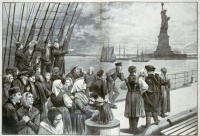From The Peopling of New York City
Ireland is the third-largest island in Europe, however, no larger than the state of Maine, able to suffice at most 8 million people, as counted in the early 19th century. This large population is the reason why the Irish soon became impoverished, not to mention when in 1801, Great Britain decided to merge with Ireland to create the United Kingdom of Great Britain and Ireland. Not only did the Irish suffer religious prejudice of the British Protestants against the Irish Catholics, but they suffered political subordination at the hands of the British Parliament.[1]
As a result, many Irish had no choice but to emigrate to the United States. Between 1820 to 1860, the Irish were never less than a third of all immigrants. By 1840, the Irish constituted nearly half of all entering immigrants.
In the 1840s, nearly 2 million Irish immigrants came to the United States. The reason? The Great Famine had left thousands of Irish with no food, no money and no clothes.[2] Emigration from Ireland increased from 40% to nearly 85%. They settled in the cities that the ships landed in, one of them being New York City, which the Irish soon made up a quarter of the population in 1850.
This flow of Irish immigrants remained constant for another five years as the first immigrants earned enough money to send for relatives and friends. After 1855 and the Civil War, the numbers that arrived became smaller and smaller. Between 1820 and 1880, almost 3.5 million Irishmen had entered the United States.[3]
New York City today has the largest number of Irish-Americans of any city in America.
- Return to Historical Development
- Return to Irish
